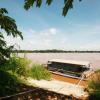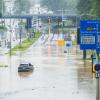Introduction
Limburg 2018. Extreme amounts of precipitation severe drought and heat cause problems and unsafe situations in our cities, on agricultural land and in our nature reserves.
The climate is changing, faster than we thought. That's how high it has been here this door was pushed out of the frame and all the water from the parking lot has flowed in, and so all the way to the store to the front flowed, and at the moment we are with a damage of around 150,000 euros that is not reimbursed. for heavy rainfall then the stream no longer process the water and then actually the water was with considerable force towards our houses and it causes a lot of nuisance for a lot of damage but also very dangerous when that happens.
With the water in balance programme, the Limburg Water Board gives priority to tackling problems in the field of flooding caused by the changing climate. For the solutions, we turn four knobs: 1) rural, outlying area 2) built-up area 3) water system, streams and stream valleys 4) limit damage in your own home.
By applying non-reversing tillage, we as farmers have already achieved a lot of results. We are currently investigating with the water board, among others, the possibilities to reduce the water run-off from the fields.
In the urban area, we are committed to more greenery and less pavement. This means that we retain more water on our own plot and that less water ends up in the sewer at our water system.
In order to absorb the consequences of climate change, we are increasing the regular buffers and not only to collect more water at the time of flooding, but also to retain more water at the time of drought.
To protect ourselves a bit we have made a construction of steel where we can then temporarily put partitions in which then the water the god side that have to lead so we have a driveway and a gate and the water quickly can flow to the street and does not flow into our home.
Together with partners from the area and residents, we are working on plans to tackle flooding because who knows the area better than the people who live here, work and recreate. Working together on water now and later. Learn more about Water in Balance at: www.waterschaplimburg.nl/waterinbalans.











Comments
The same extreme year in 2018 hit us in the North of England. Floods in the winter were followed by a drought. I think the key difference in England is that it is really hard to manage floods and drought together because politically and financially flooding is much more important (or perceived as such) the differential in resources is very large. This has led to some solutions to flooding being contradictory to what is desired for drought planning or mitigation. Working on both as a combined action plan is a much better idea but alas I don’t feel this will happen anytime soon in England we in Drought will always be the forgotten lower risk incident in comparison to the much more resourced flooding departments.
Very interesting stuff also I have been learning Dutch for the last year on and off so also helping me to revise J
Thanks Aden for your comment! Im happy to include you in the next discussion we have on this. On Monday we had an exchange between Limburg Water Authority and Slovak experts. But there will be more such exchanges in the future. Please let me know what you find would be important issues to discuss on this topic which you also think the WAC or GCA could help raise.
Best, Ase
Yes, I recognize that flooding has a lot more attention than drought, especially in a wet country like ours. And we forgot beside drought also the climate changes like health and cold, what demands also a different need of water. I think for instance to the water spraying in orchards during frost in the spring. We try to find a balance in the whole climate change question and to work multidisciplinary. But it is not easy… flooding rest number one to solve. Certainly after the flooding of this summer.
From a helicopter view, I think that the soil quality and the land use are key elements that can serve solutions to both questions of drought and flooding. It demands a change in thinking how we want to construct and control solutions.